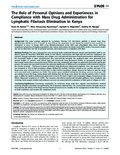| dc.description.abstract | The main strategy adopted for Lymphatic Filariasis (LF) elimination globally is annual mass drug administration (MDA) for 4 to 6 rounds. At least 65% of the population at risk should be treated in each round for LF elimination to occur. In Kenya, MDA using diethylcarbamazine citrate (DEC) and albendazole data shows declining compliance (proportion of eligible populations who receive and swallow the drugs) levels (85%–62.8%). The present study’s aim was to determine the role of personal opinions and experiences in compliance with MDA. his was a retrospective cross-sectional study conducted between January and September 2009 in two districts based on December 2008 MDA round. In each district, one location with high and one with low compliance was selected. Through systematic sampling, nine villages were selected and interviewer-based questionnaires administered to 965 household heads or adult representatives also systematically sampled. The qualitative data were generated from opinion leaders, LF patients with clinical signs and community drug distributors (CDDs) all purposively selected and interviewed. Sixteen focus group discussions (FGDs) were also conducted with single-sex adult and youth male and female groups. Chi square test was used to assess the statistical significance of differences in compliance with treatment based on the records reviewed. The house-to-house method of drug distribution influenced compliance. Over one-quarter (27%) in low compared to 15% in high compliance villages disliked this method. Problems related to size, number and taste of the drugs were more common in low (16.4%) than in high (14.4%) compliance villages. Reasons for failure to take the drugs were associated with compliance (p,0.001). The reasons given included: feeling that the drugs were not necessary, CDD not visiting to issue the drugs, being absent and thinking that the drugs were meant for only the patients with LF clinical signs. A dislike for modern medicine prevailed more in low (6.7%) than in high (1.2%) compliance villages. Experience of side effects influenced compliance (P,0.001). The common side effects experienced included giddiness, fever, headache and vomiting. Social support, alcohol and substance use were not associated with compliance in both types of villages (p.0.05). Community sensitization on treatment, drugs used, their regimen and distribution method involving all leaders should be strengthened by the Programme Implementers. The communities need to be made aware of the potential side effects of the drugs and that health personnel are on standby for the management of side effects in order to build confidence and increase the compliance levels. | en_US |

